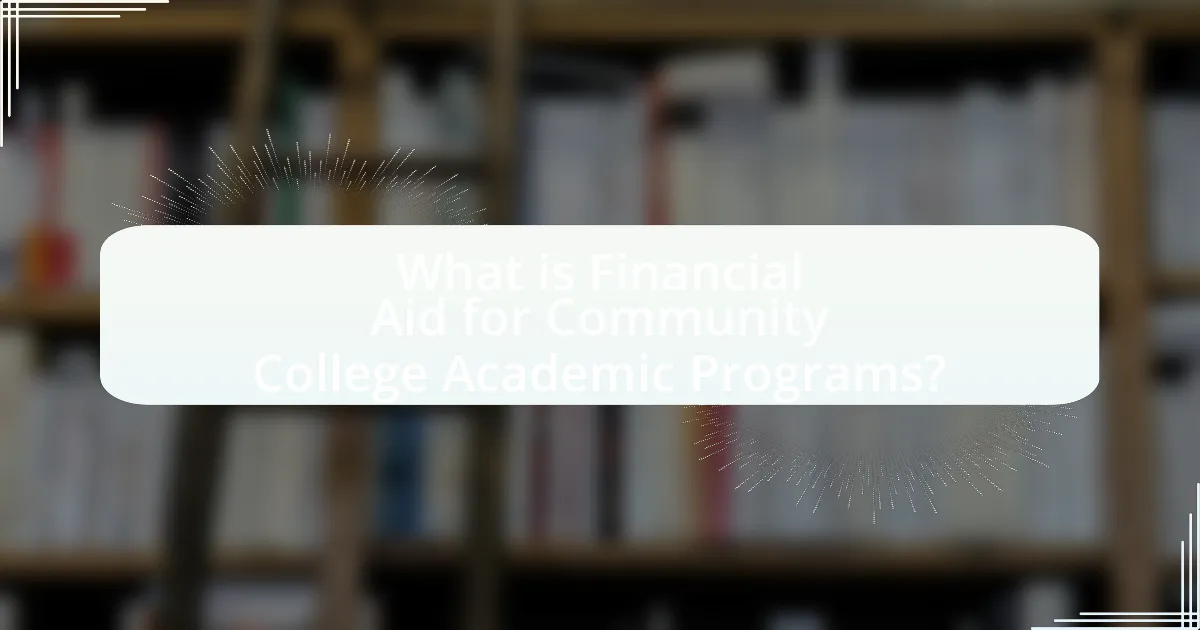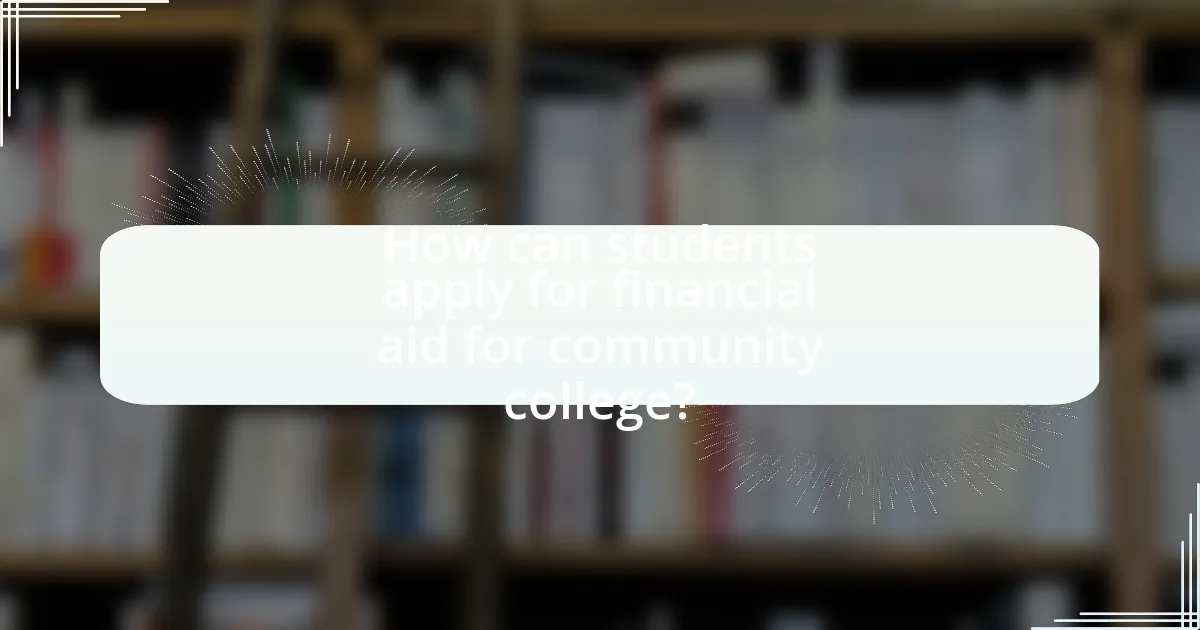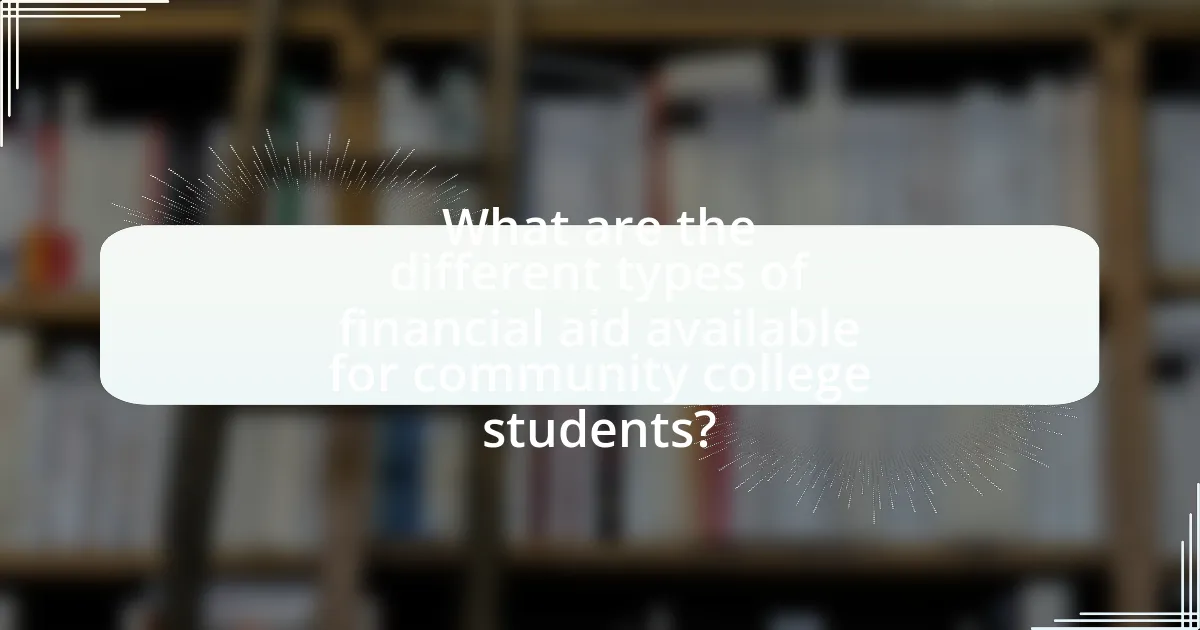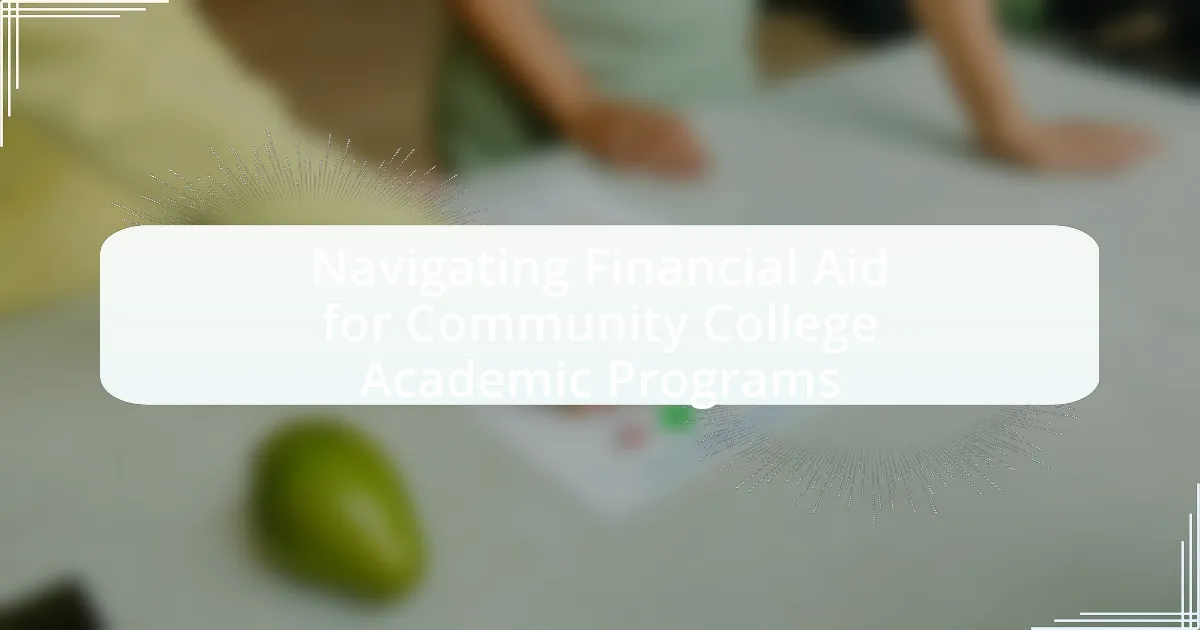Financial aid for community college academic programs encompasses various forms of financial assistance aimed at helping students manage tuition, fees, and educational expenses. This article outlines the types of financial aid available, including federal and state grants, scholarships, work-study opportunities, and loans, while emphasizing the importance of financial aid in enhancing student enrollment, retention, and academic success. It also details the application process for financial aid, eligibility requirements, and common pitfalls to avoid, providing essential resources and strategies for students to maximize their financial aid opportunities effectively.

What is Financial Aid for Community College Academic Programs?
Financial aid for community college academic programs refers to financial assistance provided to students to help cover the costs of tuition, fees, and other educational expenses associated with attending community college. This aid can come in various forms, including federal and state grants, scholarships, work-study opportunities, and low-interest loans. For instance, the Federal Pell Grant program offers need-based grants to low-income undergraduate students, which do not require repayment, thereby making higher education more accessible. Additionally, community colleges often have their own scholarship programs to support local students, further enhancing affordability and encouraging enrollment.
How does financial aid support students in community colleges?
Financial aid supports students in community colleges by providing essential financial resources that reduce the cost of tuition and related expenses. This assistance enables students to enroll in courses, purchase textbooks, and cover living costs, thereby increasing their access to education. According to the National Center for Education Statistics, approximately 60% of community college students receive some form of financial aid, which significantly alleviates the financial burden and allows them to focus on their studies rather than financial stress.
What types of financial aid are available for community college students?
Community college students have access to several types of financial aid, including federal grants, state grants, scholarships, work-study programs, and student loans. Federal grants, such as the Pell Grant, provide need-based financial assistance that does not require repayment. State grants vary by state and often target low-income students or specific demographics. Scholarships, which can be merit-based or need-based, are offered by various organizations and institutions to help cover tuition costs. Work-study programs allow students to earn money through part-time jobs while attending school, and federal and private student loans provide funds that must be repaid after graduation. According to the National Center for Education Statistics, approximately 70% of community college students receive some form of financial aid, highlighting the importance of these resources in making education accessible.
How do eligibility requirements vary for different types of financial aid?
Eligibility requirements for different types of financial aid vary significantly based on the source and type of aid. Federal financial aid, such as Pell Grants, typically requires students to demonstrate financial need through the Free Application for Federal Student Aid (FAFSA) and maintain satisfactory academic progress. State financial aid programs may have additional residency requirements and specific academic criteria, while institutional aid from community colleges often considers both financial need and merit-based factors, such as GPA or standardized test scores. Private scholarships frequently have unique eligibility criteria, including specific demographic, academic, or extracurricular qualifications. These variations reflect the diverse goals and funding sources of financial aid programs, ensuring that different student needs are addressed.
Why is financial aid important for community college students?
Financial aid is crucial for community college students because it alleviates financial barriers, enabling access to education. Many community college students come from low-income backgrounds, and without financial assistance, they may struggle to afford tuition, fees, and essential living expenses. According to the National Center for Education Statistics, approximately 60% of community college students receive some form of financial aid, which significantly increases their likelihood of completing their programs. This support not only helps students enroll but also enhances their academic success and persistence in their studies, ultimately leading to better job opportunities and economic mobility.
What impact does financial aid have on student enrollment and retention?
Financial aid significantly increases student enrollment and retention rates in community colleges. Studies show that students who receive financial aid are more likely to enroll in college and persist in their studies compared to those who do not receive aid. For instance, a report from the National Center for Education Statistics indicates that financial aid recipients have a retention rate of approximately 80%, while non-recipients have a retention rate of around 60%. This correlation highlights the critical role that financial support plays in enabling students to overcome financial barriers, thereby enhancing their likelihood of completing their academic programs.
How does financial aid influence academic success and completion rates?
Financial aid significantly enhances academic success and completion rates by alleviating financial barriers that can hinder students’ ability to focus on their studies. Research indicates that students receiving financial aid are more likely to persist in their academic programs and complete their degrees. For instance, a study by the National Center for Education Statistics found that students who received federal financial aid had a completion rate of 60% compared to 40% for those who did not receive aid. This correlation suggests that financial support not only reduces the stress associated with tuition and living expenses but also allows students to dedicate more time and resources to their education, ultimately leading to higher graduation rates.

How can students apply for financial aid for community college?
Students can apply for financial aid for community college by completing the Free Application for Federal Student Aid (FAFSA). This application determines eligibility for federal, state, and institutional financial aid, including grants, loans, and work-study programs. According to the U.S. Department of Education, submitting the FAFSA is essential for accessing over $120 billion in federal student aid annually, which supports millions of students in their pursuit of higher education.
What steps are involved in the financial aid application process?
The financial aid application process involves several key steps: completing the Free Application for Federal Student Aid (FAFSA), gathering necessary documentation, reviewing financial aid offers, and accepting the aid. First, applicants must fill out the FAFSA, which collects financial information to determine eligibility for federal, state, and institutional aid. Next, applicants need to gather documents such as tax returns, W-2 forms, and other financial records to support their application. After submitting the FAFSA, students will receive financial aid offers from their chosen institutions, which detail the types and amounts of aid available. Finally, students must review these offers and formally accept the aid they wish to receive, ensuring they meet any additional requirements set by the institution.
How do students complete the FAFSA for community college financial aid?
Students complete the FAFSA for community college financial aid by visiting the official FAFSA website and filling out the application form. The process requires students to provide personal information, financial details, and the schools they wish to attend. Completing the FAFSA is essential as it determines eligibility for federal and state financial aid, including grants, loans, and work-study programs. According to the U.S. Department of Education, over 13 million students receive financial aid through FAFSA each year, highlighting its importance in funding education.
What documentation is required for financial aid applications?
Financial aid applications typically require several key documents, including the Free Application for Federal Student Aid (FAFSA), tax returns from the previous year, W-2 forms, and proof of income. The FAFSA is essential as it determines eligibility for federal and state aid, while tax returns and W-2 forms provide necessary financial information to assess the applicant’s financial situation. Additionally, some institutions may request verification documents, such as bank statements or proof of citizenship. These requirements are standardized across many community colleges to ensure a fair evaluation of financial need.
What common mistakes should students avoid when applying for financial aid?
Students should avoid several common mistakes when applying for financial aid, including missing deadlines, providing inaccurate information, and failing to research available options. Missing deadlines can result in lost funding opportunities, as many financial aid programs have specific submission dates. Providing inaccurate information can lead to delays or denials of aid, as discrepancies may trigger further scrutiny from financial aid offices. Additionally, failing to research available options can prevent students from maximizing their financial aid packages, as they may overlook grants, scholarships, or work-study opportunities that could significantly reduce their educational costs. According to the National Association of Student Financial Aid Administrators, timely and accurate applications are crucial for securing financial support.
How can errors in the FAFSA affect financial aid eligibility?
Errors in the FAFSA can significantly impact financial aid eligibility by leading to incorrect assessments of a student’s financial need. When inaccuracies occur, such as incorrect income figures or omitted information, the resulting financial aid package may be reduced or delayed. For instance, the U.S. Department of Education relies on the information provided in the FAFSA to determine eligibility for federal grants, loans, and work-study programs; thus, any discrepancies can result in a loss of funding opportunities. Additionally, schools may use FAFSA data to allocate their own institutional aid, meaning that errors could also affect scholarships or grants offered by the college.
What are the consequences of missing financial aid deadlines?
Missing financial aid deadlines can result in the loss of eligibility for grants, scholarships, and loans, significantly impacting a student’s ability to finance their education. When deadlines are not met, students may miss out on federal aid programs such as Pell Grants, which provide substantial financial support based on need. Additionally, state-specific financial aid opportunities may also be forfeited, further limiting available resources. According to the National Association of Student Financial Aid Administrators, timely applications are crucial, as many funds are awarded on a first-come, first-served basis. Consequently, students who fail to adhere to these deadlines may face increased financial burdens or may need to seek alternative funding sources, which can complicate their academic journey.

What are the different types of financial aid available for community college students?
Community college students have access to several types of financial aid, including federal grants, state grants, scholarships, work-study programs, and student loans. Federal grants, such as the Pell Grant, provide need-based financial assistance that does not require repayment, while state grants vary by state and often target specific populations or fields of study. Scholarships, which can be merit-based or need-based, are offered by various organizations and institutions to help cover tuition costs. Work-study programs allow students to earn money through part-time employment while attending school, and student loans provide funds that must be repaid with interest after graduation. According to the National Center for Education Statistics, approximately 70% of community college students receive some form of financial aid, highlighting the importance of these resources in making education accessible.
What are federal financial aid options for community college students?
Federal financial aid options for community college students include Pell Grants, Federal Supplemental Educational Opportunity Grants (FSEOG), Federal Work-Study, and federal student loans such as Direct Subsidized and Unsubsidized Loans. Pell Grants provide need-based financial assistance that does not require repayment, while FSEOG offers additional funds to students with exceptional financial need. Federal Work-Study allows students to earn money through part-time jobs, helping to cover educational expenses. Direct Subsidized Loans are available to students with demonstrated financial need, while Unsubsidized Loans are available regardless of need, both requiring repayment after graduation. These options are designed to make higher education more accessible and affordable for community college students.
How do Pell Grants differ from federal student loans?
Pell Grants are need-based financial aid that does not require repayment, while federal student loans are borrowed funds that must be repaid with interest. Pell Grants are awarded based on financial need as determined by the Free Application for Federal Student Aid (FAFSA) and can provide up to $7,395 for the 2023-2024 academic year. In contrast, federal student loans, such as Direct Subsidized and Unsubsidized Loans, require students to repay the borrowed amount plus interest, which accrues over time. This fundamental difference highlights that Pell Grants serve as a form of gift aid, whereas federal student loans represent a financial obligation.
What role do work-study programs play in financial aid?
Work-study programs provide financial aid by allowing students to earn money through part-time employment while enrolled in college. These programs are funded by the federal government and educational institutions, enabling students to offset tuition and living expenses. According to the National Center for Education Statistics, approximately 700,000 students participated in federal work-study programs in the 2019-2020 academic year, demonstrating their significance in supporting students’ financial needs. By integrating work experience with academic pursuits, work-study programs not only alleviate financial burdens but also enhance students’ employability skills.
What state and local financial aid programs exist for community college students?
State and local financial aid programs for community college students include state grants, scholarships, and work-study programs. For example, California offers the California College Promise Grant, which waives enrollment fees for eligible students, while New York has the Excelsior Scholarship, covering tuition for students attending community colleges who meet specific residency and income requirements. Additionally, many states provide local scholarships through community foundations and organizations that target community college students, enhancing access to education. These programs are designed to alleviate the financial burden on students and promote higher education attainment.
How can students find state-specific financial aid opportunities?
Students can find state-specific financial aid opportunities by visiting their state’s higher education agency website, which typically lists available grants, scholarships, and loans. Each state has unique programs designed to support residents pursuing higher education, such as the California Dream Act for undocumented students or the Texas Grant program for low-income students. Additionally, students can utilize resources like the FAFSA (Free Application for Federal Student Aid) to access federal and state aid, as many states require this application for their financial aid programs. According to the National Association of Student Financial Aid Administrators, over 40 states offer their own financial aid programs, making it essential for students to research and apply for these opportunities specific to their state.
What are the benefits of local scholarships for community college students?
Local scholarships provide significant financial relief for community college students, enabling them to cover tuition and related expenses without incurring substantial debt. These scholarships often have fewer applicants compared to national scholarships, increasing the likelihood of receiving funding. Additionally, local scholarships may be tailored to specific community needs or demographics, fostering a sense of community support and engagement. For instance, according to the National Scholarship Providers Association, local scholarships can enhance access to education for underrepresented groups, thereby promoting diversity within academic institutions.
What private financial aid options are available for community college students?
Private financial aid options available for community college students include private scholarships, grants from nonprofit organizations, and private loans. Private scholarships are often offered by local businesses, community foundations, and educational organizations, providing funds that do not need to be repaid. Nonprofit organizations may also provide grants specifically aimed at supporting community college students, which can help cover tuition and other educational expenses. Additionally, private loans from banks or credit unions can be an option, although they typically require repayment with interest. According to the National Center for Education Statistics, approximately 30% of community college students utilize some form of private financial aid to help finance their education.
How do private loans compare to federal loans for community college students?
Private loans typically have higher interest rates and less favorable repayment terms compared to federal loans for community college students. Federal loans offer fixed interest rates, income-driven repayment plans, and potential loan forgiveness options, which are not generally available with private loans. For instance, federal Direct Subsidized Loans have an interest rate of 4.99% for the 2023-2024 academic year, while private loans can vary widely, often exceeding 10% based on creditworthiness. Additionally, federal loans do not require a credit check, making them more accessible for students with limited credit history, unlike private loans that often do.
What are the advantages and disadvantages of private scholarships?
Private scholarships offer several advantages and disadvantages. The primary advantage is that they can significantly reduce the financial burden of education, allowing students to cover tuition and other expenses without incurring debt. According to the National Center for Education Statistics, private scholarships contributed to nearly $7 billion in financial aid for students in 2020, demonstrating their impact on affordability.
However, a notable disadvantage is that private scholarships often come with specific eligibility criteria and conditions, which can limit access for some students. For instance, many private scholarships require a minimum GPA or specific extracurricular involvement, potentially excluding qualified candidates who do not meet these requirements. Additionally, some private scholarships may be renewable only for a limited number of years, creating uncertainty for long-term financial planning.

How can students maximize their financial aid for community college?
Students can maximize their financial aid for community college by completing the Free Application for Federal Student Aid (FAFSA) accurately and on time. Submitting the FAFSA allows students to access federal grants, state aid, and institutional scholarships, which can significantly reduce tuition costs. According to the U.S. Department of Education, over 13 million students receive financial aid through FAFSA each year, highlighting its importance in funding education. Additionally, students should research and apply for scholarships specific to their community college, as many institutions offer unique funding opportunities that are not widely advertised. Engaging with financial aid advisors at the college can also provide personalized guidance and help identify additional resources.
What strategies can students use to increase their financial aid eligibility?
Students can increase their financial aid eligibility by completing the Free Application for Federal Student Aid (FAFSA) accurately and on time. Timely submission of the FAFSA is crucial, as many financial aid programs have limited funds and operate on a first-come, first-served basis. Additionally, students should maintain satisfactory academic progress, as most financial aid requires a minimum GPA or completion rate. Engaging in financial literacy programs can also help students understand and manage their finances better, potentially leading to increased eligibility for need-based aid. Furthermore, students should explore scholarship opportunities, as many organizations offer funds that do not require repayment, which can supplement financial aid packages.
How does maintaining a good GPA affect financial aid opportunities?
Maintaining a good GPA positively affects financial aid opportunities by making students eligible for various scholarships and grants that require a minimum academic standard. Many financial aid programs, including federal and state grants, as well as institutional scholarships, have GPA requirements that students must meet to qualify. For instance, the Federal Pell Grant program mandates that students maintain satisfactory academic progress, which often includes maintaining a GPA of at least 2.0. Additionally, many merit-based scholarships specifically target students with GPAs above a certain threshold, often around 3.0 or higher, thereby increasing the likelihood of receiving financial support.
What role does enrollment status play in financial aid eligibility?
Enrollment status significantly impacts financial aid eligibility, as it determines the type and amount of aid a student can receive. Full-time students typically qualify for a broader range of financial aid options, including federal grants, state aid, and institutional scholarships, while part-time students may have limited access to these resources. For instance, the Free Application for Federal Student Aid (FAFSA) requires students to indicate their enrollment status, which directly influences the calculation of their Expected Family Contribution (EFC) and eligibility for aid programs. Additionally, many scholarships specifically require full-time enrollment, further emphasizing the importance of enrollment status in securing financial assistance.
What resources are available to help students navigate financial aid?
Students can access various resources to navigate financial aid, including the Free Application for Federal Student Aid (FAFSA), financial aid offices at community colleges, and online platforms like College Board and Ed.gov. The FAFSA is essential for determining eligibility for federal and state aid, while financial aid offices provide personalized assistance and guidance on available scholarships, grants, and loans. Additionally, College Board offers tools and information on financial aid options, and Ed.gov provides comprehensive resources and updates on federal financial aid programs. These resources collectively support students in understanding and securing financial aid for their academic pursuits.
How can community college financial aid offices assist students?
Community college financial aid offices assist students by providing guidance on available financial aid options, including federal and state grants, scholarships, and work-study programs. These offices help students complete the Free Application for Federal Student Aid (FAFSA), ensuring they understand eligibility requirements and deadlines. Additionally, financial aid offices offer personalized counseling to help students create financial plans that align with their educational goals. According to the National Center for Education Statistics, approximately 70% of community college students receive some form of financial aid, highlighting the critical role these offices play in making education accessible.
What online tools and resources can help students understand financial aid?
Online tools and resources that can help students understand financial aid include the Free Application for Federal Student Aid (FAFSA) website, which provides essential information on federal aid eligibility and application processes. Additionally, the College Board’s Scholarship Search tool allows students to find scholarships tailored to their needs, while the National Association of Student Financial Aid Administrators (NASFAA) offers comprehensive guides and webinars on financial aid topics. These resources are validated by their widespread use and endorsement by educational institutions, ensuring students have access to accurate and relevant information for navigating financial aid effectively.
What are the best practices for managing financial aid effectively?
The best practices for managing financial aid effectively include maintaining accurate records, understanding eligibility requirements, and communicating regularly with financial aid offices. Accurate record-keeping ensures that all necessary documents are submitted on time, which is crucial for meeting deadlines and avoiding delays in funding. Understanding eligibility requirements helps students identify the types of aid they qualify for, such as grants, scholarships, and loans, allowing them to maximize their financial support. Regular communication with financial aid offices provides students with updates on their application status and any changes in policies or funding availability, ensuring they remain informed and can make timely decisions regarding their education financing.
How can students budget their financial aid funds throughout the semester?
Students can budget their financial aid funds throughout the semester by creating a detailed spending plan that aligns with their financial aid disbursement schedule. This involves calculating total available funds, estimating monthly expenses such as tuition, books, housing, and personal costs, and allocating specific amounts for each category. For instance, if a student receives $5,000 in financial aid for the semester, they should divide this amount by the number of months in the semester to determine a monthly budget, ensuring they do not overspend in the early weeks. Additionally, tracking expenses regularly and adjusting the budget as needed can help maintain financial stability. Research indicates that students who actively manage their budgets are more likely to succeed academically and avoid financial stress, as highlighted in studies by the National Center for Education Statistics.
What should students do if they encounter financial aid issues during their studies?
Students encountering financial aid issues during their studies should immediately contact their financial aid office for assistance. The financial aid office is equipped to provide guidance on resolving issues, such as discrepancies in aid amounts or eligibility concerns. Additionally, students should gather all relevant documentation, including award letters and communication records, to facilitate the resolution process. According to the National Association of Student Financial Aid Administrators, timely communication with financial aid offices can significantly improve the chances of resolving issues effectively.

Leave a Reply